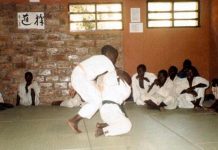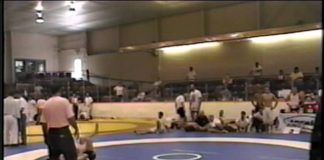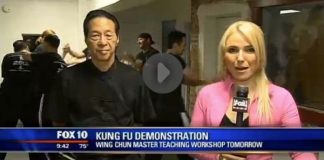In a time long before neon nunchucks and custom designed gi’s those who practiced martial arts did it primarily as a means of self defense; a way to protect themselves against armed and un-armed attackers.
Using the empty hand like an ax or hammer to penetrate an enemies protective chest plate, usually made of bamboo, required rock-hard knuckles and a stone-like edge on the side of their hand and foot.
To perfect their chopping, striking, and kicking techniques these ancient warriors would practice smashing a variety of inanimate objects. Their sole purpose was to perfect their “weapons” for combat.
Today the art of breaking has evolved to an event that displays the power of the empty hand (and foot) in shows that range from karate demos at the local recreation center to network television specials. Breaking has emerged as a stand-alone sport and those who excel in creating new, unusual, and exotic ways of smashing everything from tons of ice to baseball bats have become superstars in their own right.
33-year-old Leif Becker is the newest star in the breaking game. As part of Black Belt Magazine’s First Annual Festival of Martial Arts, Becker and Team Bergamo and Schick Quattro were invited to do a breaking demonstration. Part of that event was Becker’s attempt to set a World’s Record by breaking 487 boards in one minute.
Throngs of excited spectators gathered outside of Universal Studio Hollywood’s City Walk as Becker prepared for his quest. The ¾ inch boards were placed in stacks of five running a gauntlet of nearly half a city block.
Like a thoroughbred straining to get out of the starting gate, Becker paced anxiously, with the clicking of the official stopwatch he was off to the races. Using his right hand like an ax Becker blazed past each stack of boards leaving nothing but kindling in his wake.
An army of paparazzi ran along side of him, their shutters clicking as fast as possible in an effort to keep up with Becker. Moving like a human vegematic his chopping hand was almost a blur in the camera lens, destroying a pile of wood with every downward stroke. 59.9 seconds later the Tang Soo Do black belt had earned his way into the record book. His 15-minutes of fame had finally arrived and he was greeted by the crowd as if he’d just won an Olympic Gold medal.
The record he set won’t be found in the Guiness Book of World Records because the publishers have eliminated that event from their on going coverage of record-breaking attempts.
“This record is recognized by the International Sports Karate Association (ISKA) as well as the United States Breaking Association” (USBA), Becker explained. “When I originally went to break the world record I called Guiness and they said they were no longer recognizing that event at all. Mike Reeves, the previous world record holder is the only person in the Guiness Book of Records. Regardless of who does what in the future, Mike is the guy in the book. That’s why I had to go out and find an organization that would recognize and sanction my break.”
The heart of this story isn’t the fact that Becker broke enough boards to build a small house in under 60 seconds, or that his name is on a scroll until the next guy breaks his record, the heart of this event is as old as the martial arts itself.
By taking the ancient art of uchi-waza (striking techniques) to another level that is part and parcel of 21st Century martial arts Becker has raised the bar in promoting this aspect of the martial arts. To perfect ones breaking skills two elements have always been paramount. One is developing the body to accomplish the task, and the other is developing the mind to will the body onward in the competition of that task.
The force of atemi, according to physical dynamics, is directly related to the degree of velocity and mass. As velocity and mass are added to a blow of a masterful focus and technique, more destructive power is obtained.
Velocity is generally increased by training the extensor and flexor muscles by continuous and repetitive practice which has evolved over the decades. Traditional practitioners achieve this through repetitive practice of kata, and free fighting plus weight training.
Today many martial artists, like Becker, incorporate Peak Performance Training, a form of Neural Linguistic Programming (NLP), high level cardio workouts with a dash of old school training tossed in for good measure.
“Top Peak performers always look for what is best in everything and every situation,” says martial arts master and Peak Performance trainer John St. James. “I have worked for years with Mr. Becker on Peak Performance Training; he embraced the concept and has used these skills to achieve great things.”
“Peak Performance Training is the balance of yourself and development within yourself,” Becker explained. “My failure used to come due to a lack of balance within. The break at Universal Studio was my fourth attempt. The third attempt I tied the record and the second attempt was one of my worse showings and it was due to a lack of balance within. I over trained physically but didn’t allow myself to adjust emotionally and spiritually just to gain that inner sense of strength. That’s when Master St. James began working with me, helping me to prepare myself mentally and set goals, which is part of Peak Performance Training.”
To prepare for his big day at Universal Studio Becker began working with Master Ralph Bergamo owner of Team Bergamo. Best known for their spectacular breaking on ESPN’s martial art series, Team Bergamo breakers hold several power breaking records.
Becker’s training regiment consisted of cardio vascular training which was imperative for the 60 second burst of energy required to run the length of the 487 plus boards.
“We really focused on strength and conditioning to develop my endurance for a 60 second maximum burst of speed,” said Becker. “Building the mental factor was just as important as building my physical ability to accomplish the task.”
In addition to his Peak Performance Training, Becker did a lot of old school breaking as part of his weekly regiment.
“Although there aren’t many scars on my hand from makiwara training, the bones in my right hand are as hard as a rock,” said Becker. “I’ll break 50 or 60 boards in a day and never feel it. Every day I’d do about 300 strikes a day on wood or concrete to condition the bone in my hand. At this point and time I’ve probably broken 5,000 boards with my right hand and it doesn’t phase me a bit. While that kind of training is important I think the most important thing to be a successful breaker is in developing your technique. It’s a persons technique is what’s going to give you your speed and accuracy.”
While Becker has a perfectly conditioned striking hand, the body can only do what the mind wills, and as a speed breaker this 3rd degree black belt must also be in top physical and mental condition.
“After 20 or 30 seconds my muscles will begin to fatigue, so it’s imperative to be mentally determined to do what has to be done,” said Becker. “To determine what set-up was the best for me we practiced breaking stacks of four, then five. The first time I attempted to break the record I did a hundred stacks of five, the second attempt I did stacks of four, and each time I fell short of breaking the record although I did tie the record once on national television.”
In May of 2004 Becker was invited by David Letterman to attempt his world-breaking on The Late Show. An entire New York City block was ringed off in front of CBS for Becker’s event. Surrounded by hundreds of curious strangers and a viewing audience of millions the black belt from Connecticut, for the 3rd time attempted to break the world’s record.
“That was one stressful day for me,” said Becker. “I tied the world’s record breaking 415 boards. I felt good about the break but at the end of 60-seconds I didn’t know what the final count was. There was a lot of commotion during the official count, and after the commercial break I found out that I was just one board short of the record.”
Following his 15-minutes of network fame Becker and Team Bergamo began to prepare for the next attempt which would come 14 months later in Los Angeles where he finally achieved his goal in outstanding fashion.
“Breaking is a very important aspect of martial arts training,” said Becker. “It is a true test of a martial artist’s effectiveness. Breaking tests your skill level and makes you do things correctly. For example if your follow through isn’t focused, or if your form is poor and you hit or kick an object without proper power and speed the break will not be successful. So breaking gives you the chance to learn and understand and perfect techniques to their fullest effect.”
Becker went on to explain that the secret to his success in breaking is that last second snapping action of his wrist that creates tension, follow-through and power. He stresses learning the mechanics of body movement as applied to follow through and developing a strong sense of focus so that the breaker is always aware of where his or her blow must land for maximum effectiveness.
“It doesn’t matter if your breaking boards, cement, coconuts or baseball bats whatever the object is you have to break through mentally because without the proper mindset failure is emanate,” said Becker. “Most of the injuries in this sport occur when a person isn’t focused on what they’re doing. The reason Team Bergamo is so successful is because we work together to develop a sense of energy without allowing it to overtake or overwhelm us.”





